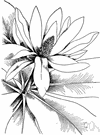umbrella tree
n.
1. A small magnolia tree (Magnolia tripetala) of the southeast United States, having large leaves clustered in an umbrellalike form at the ends of the branches.
2. See schefflera.
American Heritage® Dictionary of the English Language, Fifth Edition. Copyright © 2016 by Houghton Mifflin Harcourt Publishing Company. Published by Houghton Mifflin Harcourt Publishing Company. All rights reserved.
umbrella tree
n
1. (Plants) a North American magnolia, Magnolia tripetala, having long leaves clustered into an umbrella formation at the ends of the branches and unpleasant-smelling white flowers
2. (Plants) Also called: umbrella bush any of various other trees or shrubs having leaves shaped like an umbrella or growing in an umbrella-like cluster
Collins English Dictionary – Complete and Unabridged, 12th Edition 2014 © HarperCollins Publishers 1991, 1994, 1998, 2000, 2003, 2006, 2007, 2009, 2011, 2014
umbrel′la tree`
n.
1. an American magnolia, Magnolia tripetala, having large leaves in umbrellalike clusters.
2. any of various other trees resembling an umbrella.
[1730–40, Amer.]
Random House Kernerman Webster's College Dictionary, © 2010 K Dictionaries Ltd. Copyright 2005, 1997, 1991 by Random House, Inc. All rights reserved.
ThesaurusAntonymsRelated WordsSynonymsLegend:
| Noun | 1. |  umbrella tree - erect evergreen shrub or small tree of Australia and northern New Guinea having palmately compound leaves umbrella tree - erect evergreen shrub or small tree of Australia and northern New Guinea having palmately compound leavesgenus Schefflera, Schefflera - large genus of shrubby and climbing tropical plants having showy digitately compound foliage |
| 2. |  umbrella tree - small deciduous tree of eastern North America having creamy white flowers and large leaves in formations like umbrellas at the ends of branches umbrella tree - small deciduous tree of eastern North America having creamy white flowers and large leaves in formations like umbrellas at the ends of branchesmagnolia - any shrub or tree of the genus Magnolia; valued for their longevity and exquisite fragrant blooms |
Based on WordNet 3.0, Farlex clipart collection. © 2003-2012 Princeton University, Farlex Inc.